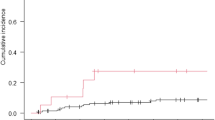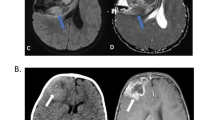Abstract
Background
Atypical teratoid rhabdoid tumor (ATRT) is a highly aggressive disease of embryonic origin accounting for <5% of all pediatric central nervous system (CNS) tumors.
Patients and methods
We describe a series of five cases of CNS ATRT. The first three patients underwent subtotal tumor resection. Gross total resection of the tumor was achieved in the fourth and fifth patients. Only 4 patients received chemotherapy, whereas all 5 patients received additive radiotherapy (RT). The latter included three dimensional (3D) conformal RT or intensity modulated RT (IMRT) with a median dose of 54 Gy (range 50.4–59.0 Gy) applied in daily fractions of 1.8 Gy. The median interval between surgery and RT was 5 months (range 2–11 months).
Results
Two months after completion of RT, 4 patients had achieved complete radiologic remission. The median event-free survival period was 46 months (range 10–90 months). However, the first patient died 17 months after developing an out-of-field recurrence. The third patient developed a recurrence 11 months after salvage RT. The other 3 patients (cases 2, 4, and 5) remain alive with no evidence of disease 59, 46 and 90 months after therapy, respectively.
Conclusion
Overall, the 5 patients survived for a median of 48 months (range 25–90 months) from the time of initial diagnosis and they tolerated the RT well, without severe acute or late onset toxicities. The results imply a potential survival gain after irradiation at acceptable toxicity level.
Zusammenfassung
Hintergrund
Atypische teratoide Rhabdoidtumore (ATRT) sind eine hoch aggressive Erkrankung embryonalen Ursprungs und repräsentieren <5% aller pädiatrischen Tumore des zentralen Nervensystems (ZNS).
Patienten und Methoden
Wir beschreiben eine Fallserie von 5 Patienten mit ATRT des ZNS. Bei den ersten 3 Patienten wurde eine subtotale Resektion des Tumors durchgeführt. Bei den anderen beiden Patienten wurden eine komplette Resektion des Tumors erreicht. Eine Chemotherapie erhielten 4 Patienten. Alle 5 Patienten bekamen eine additive Radiotherapie (RT). Eine dreidimensionale (3D) konformale RT oder intensitätmodulierte RT (IMRT) wurde mit einer mittleren Dosis von 54 Gy (Spanne 50,4–59,0 Gy) in einer täglichen Fraktionierung von 1,8 Gy durchgeführt. Das mediane Intervall zwischen Operation und RT betrug 5 Monate (Spanne 2–11 Monate).
Ergebnisse
Zwei Monate nach Abschluss der RT zeigten 4 Patienten eine komplette radiologische Remission. Die mediane ereignisfreie Überlebenszeit betrug 46 Monate (Spanne 10–90 Monate). Allerdings starb der erste Patient 17 Monate nach Entwicklung eines „Out-of-field“-Rezidivs. Der dritte Patient entwickelt ein Rezidiv 11 Monaten nach Salvage-RT. Die anderen 3 Patienten (Fall 2, 4 und 5) sind bisher 59, 46 und 90 Monate nach der Behandlung tumorfrei.
Zusammenfassung
Die mediane Gesamtüberlebenszeit seit Erstdiagnose beträgt 48 Monate (Spanne 25–90 Monate). Die RT wurde insgesamt ohne schwere akute oder späte Toxizitäten vertragen. Die Ergebnisse implizieren einen möglichen Überlebensgewinn nach der Bestrahlung mit einem akzeptablen Toxizitätsniveau.






Similar content being viewed by others
References
Bishop AJ, McDonald MW, Chang AL et al (2012) Infant brain tumors. Incidence, survival, and the role of radiation based on surveillance, epidemiology, and end results (SEER) data. Int J Radiat Oncol Biol Phys 82(1):341–347. doi:10.1016/j.ijrobp.2010.08.020
Buscariollo DL, Park HS, Roberts KB et al (2012) Survival outcomes in atypical teratoid rhabdoid tumor for patients undergoing radiotherapy in a surveillance, epidemiology, and end results analysis. Cancer 118(17):4212–4219. doi:10.1002/cncr.27373
Lau CS, Mahendraraj K, Chamberlain RS (2015) Atypical teratoid rhabdoid tumors: a population-based clinical outcomes study involving 174 patients from the surveillance, epidemiology, and end results database (1973–2010). Cancer Manag Res 7:301–309. doi:10.2147/CMAR.S88561
Sinha P, Ahmad M, Varghese A et al (2015) Atypical teratoid rhabdoid tumour of the spine: report of a case and literature review. Eur Spine J 24:S472–S484. doi:10.1007/s00586-014-3445-1
Schneiderhan TM, Beseoglu K, Bergmann M et al (2011) Sellar atypical teratoid/rhabdoid tumours in adults. Neuropathol Appl Neurobiol 37(3):326–329. doi:10.1111/j.1365-2990.2010.01111.x
Packer RJ, Biegel JA, Blaney S et al (2002) Atypical teratoid/rhabdoid tumor of the central nervous system: report on workshop. J Pediatr Hematol Oncol 24(5):337–342. doi:10.1097/00043426-200206000-00004
Takahashi K, Nishihara H, Katoh M et al (2011) A case of atypical teratoid/rhabdoid tumor in an adult, with long survival. Brain Tumor Pathol 28(1):71–76. doi:10.1007/s10014-010-0008-y
Lee Y, Yang Y, Huang M et al (2014) MicroRNA142-3p promotes tumor-initiating and radioresistant properties in malignant pediatric brain tumors. Cell Transplant 23(4):669–690. doi:10.3727/096368914X678364
Venkataraman S, Alimova I, Tello T et al (2012) Targeting Aurora Kinase A enhances radiation sensitivity of atypical teratoid rhabdoid tumor cells. J Neurooncol 107(3):517–526. doi:10.1007/s11060-011-0795-y
Alimova I, Birks DK, Harris PS et al (2013) Inhibition of EZH2 suppresses self-renewal and induces radiation sensitivity in atypical rhabdoid teratoid tumor cells. Neuro-oncology 15(2):149–160. doi:10.1093/neuonc/nos285
Knipstein JA, Birks DK, Donson AM et al (2012) Histone deacetylase inhibition decreases proliferation and potentiates the effect of ionizing radiation in atypical teratoid/rhabdoid tumor cells. Neuro-oncology 14(2):175–183. doi:10.1093/neuonc/nor208
Morgenstern DA, Gibson S, Brown T et al (2010) Clinical and pathological features of paediatric malignant rhabdoid tumours. Pediatr Blood Cancer 54(1):29–34. doi:10.1002/pbc.22231
Chi SN, Zimmerman MA, Yao X et al (2008) Intensive multimodality treatment for children with newly diagnosed CNS atypical teratoid rhabdoid tumor. J Clin Oncol 27(3):385–389. doi:10.1200/JCO.2008.18.7724
Park HG, Yoon JH, Kim SH et al (2014) Adult-onset sellar and suprasellar atypical teratoid Rhabdoid tumor treated with a multimodal approach. A case report. Brain Tumor Res Treat 2(2):108 doi:10.14791/btrt.2014.2.2.108
Lafay-Cousin L, Fay-McClymont T, Johnston D et al (2015) Neurocognitive evaluation of long term survivors of atypical teratoid rhabdoid tumors (ATRT). The Canadian registry experience. Pediatr Blood Cancer 62(7):1265–1269. doi:10.1002/pbc.25441
Slavc I, Chocholous M, Leiss U et al (2014) Atypical teratoid rhabdoid tumor. Improved long-term survival with an intensive multimodal therapy and delayed radiotherapy. The Medical University of Vienna experience 1992–2012. Cancer Med 3(1):91–100. doi:10.1002/cam4.161
Verma V, Johnson CP, Bennion NR et al (2015) Atypical teratoid rhabdoid tumor: long-term survival after chemoradiotherapy. Childs Nerv Syst. doi:10.1007/s00381-015-2723-5
Bouvier C, Paula AM de, Fernandez C et al (2008) Atypical teratoid/rhabdoid tumour. 7‑year event-free survival with gross total resection and radiotherapy in a 7‑year-old boy. Childs Nerv Syst 24(1):143–147. doi:10.1007/s00381-007-0438-y
Tekautz TM, Fuller CE, Blaney S et al (2005) Atypical teratoid/rhabdoid tumors (ATRT): improved survival in children 3 years of age and older with radiation therapy and high-dose alkylator-based chemotherapy. J Clin Oncol 23(7):1491–1499. doi:10.1200/JCO.2005.05.187
Squire SE, Chan MD, Marcus KJ (2007) Atypical teratoid/rhabdoid tumor: the controversy behind radiation therapy. J Neurooncol 81(1):97–111. doi:10.1007/s11060-006-9196-z
Patel S, Bhatnagar A, Wear C et al (2014) Are pediatric brain tumors on the rise in the USA? Significant incidence and survival findings from the SEER database analysis. Childs Nerv Syst 30(1):147–154. doi:10.1007/s00381-013-2307-1
Combs SE, Nüsslin F, Wilkens JJ (2016) Individualized radiotherapy by combining high-end irradiation and magnetic resonance imaging. Strahlenther Onkol 192(4):209–215. doi:10.1007/s00066016-0944-5
Takahashi-Fujigasaki J, Matumoto M, Kan I et al (2012) Atypical teratoid/rhabdoid tumor with 26-year overall survival: case report. J Neurosurg Pediatr 9(4):400–405. doi:10.3171/2012.1.PEDS11350
Benesch M, Bartelheim K, Fleischhack G et al (2014) High-dose chemotherapy (HDCT) with auto-SCT in children with atypical teratoid/rhabdoid tumors (AT/RT): a report from the European Rhabdoid Registry (EU-RHAB). Bone Marrow Transplant 49(3):370–375. doi:10.1038/bmt.2013.208
Hoff K von, Hinkes B, Dannenmann-Stern E et al (2011) Frequency, risk-factors and survival of children with atypical teratoid rhabdoid tumors (AT/RT) of the CNS diagnosed between 1988 and 2004, and registered to the German HIT database. Pediatr Blood Cancer 57(6):978–985. doi:10.1002/pbc.23236
Peters O, Marienhagen J, Stadler P et al (2007) Combined multimodality therapy for pedaitric central nervous system atypical teratoid/rhabdoid tumor: an interim analysis of the German ATRT/CNS pilot study. Abstract 148. Neuro-oncology 9(2):169–221. doi:10.1215/15228517-2006-039
Park ES, Sung KW, Baek HJ et al (2012) Tandem high-dose chemotherapy and autologous stem cell transplantation in young children with atypical teratoid/rhabdoid tumor of the central nervous system. J Korean Med Sci 27(2):135 doi:10.3346/jkms.2012.27.2.135
Schrey D, Carceller Lechón F, Malietzis G et al (2015) Multimodal therapy in children and adolescents with newly diagnosed atypical teratoid rhabdoid tumor: individual pooled data analysis and review of the literature. J Neurooncol. doi:10.1007/s11060-015-1904-0
Athale UH, Duckworth J, Odame I et al (2009) Childhood atypical teratoid rhabdoid tumor of the central nervous system a meta-analysis of observational studies. J Pediatr Hematol Oncol 31(9):651–663
Blaney SM, Kocak M, Gajjar A et al (2012) Pilot study of systemic and intrathecal mafosfamide followed by conformal radiation for infants with intracranial central nervous system tumors. A Pediatric Brain Tumor Consortium Study (PBTC-001). J Neurooncol 109(3):565–571. doi:10.1007/s11060-012-0929-x
Kocher M, Wittig A, Piroth MD et al (2014) Stereotactic radiosurgery for treatment of brain metastases. A report of the DEGRO Working Group on stereotactic radiotherapy. Strahlenther Onkol 190(6):521–532. doi:10.1007/s00066-014-0648-7
Hirth A, Pedersen PH, Wester K et al (2003) Cerebral atypical teratoid/rhabdoid tumor of infancy: long-term survival after multimodal treatment, also including triple intrathecal chemotherapy and gamma knife radiosurgery – case report. Pediatr Hematol Oncol 20(4):327–332. doi:10.1080/08880010390203116
Timmermann B (2015) Proton therapy of brain tumors: chance or risk? Strahlenther Onkol 191(8):689–690
Perreault S, Lober RM, Carret A et al (2013) Relapse patterns in pediatric embryonal central nervous system tumors. J Neurooncol 115(2):209–215. doi:10.1007/s11060-013-1213-4
Pixberg C, Koch R, Eich HT et al (2016) Acute toxicity grade 3 and 4 after irradiation in children and adolescents. Results from the IPPARCA collaboration. Int J Radiat Oncol Biol Phys 94(4):792–799. doi:10.1016/j.ijrobp.2015.12.353
Padovani L, André N, Constine LS et al (2012) Neurocognitive function after radiotherapy for paediatric brain tumours. Nat Rev Neurol 8(10):578–588. doi:10.1038/nrneurol.2012.182
Weiler LJ, Pletschko T, Schwarzinger A et al (2015) Attention functioning following radiotherapy in children with brain tumors. Strahlenther Onkol 191(8):689
Shitara S, Akiyama Y (2014) Atypical teratoid/rhabdoid tumor in sellar turcica in an adult: a case report and review of the literature. Surg Neurol Int 5:75 doi:10.4103/2152-7806.133105
Gorayski P, Boros S, Ong B et al (2013) Radiation-induced primary cerebral atypical teratoid/rhabdoid tumour in an adult. J Clin Neurosci 20(10):1466–1468. doi:10.1016/j.jocn.2013.03.041
Leon-Bojorge B de, Rueda-Franco F, Anaya-Jara M (2008) Central nervous system atypical teratoid rhabdoid tumor: experience at the National Institute of Pediatrics, Mexico City. Childs Nerv Syst 24(3):307–312. doi:10.1007/s00381-007-0464-9
Arita K, Sugiyama K, Sano T et al (2008) Atypical teratoid/rhabdoid tumour in sella turcica in an adult. Acta Neurochir (Wien) 150(5):491–496. doi:10.1007/s00701-008-1500-y
Makuria AT, Rushing EJ, McGrail KM et al (2008) Atypical teratoid rhabdoid tumor (AT/RT) in adults: review of four cases. J Neurooncol 88(3):321–330. doi:10.1007/s11060-008-9571-z
Chen YW, Wong TT, Ho DM et al (2006) Impact of radiotherapy for pediatric CNS atypical teratoid/rhabdoid tumor (single institute experience). Int J Radiat Oncol Biol Phys 64(4):1038–1043. doi:10.1016/j.ijrobp.2005.10.001
Raisanen J, Biegel JA, Judkins A et al (2005) Chromosome 22q deletions in atypical teratoid/rhabdoid tumors in adults. Brain Pathol 15(1):23–28
Zimmerman MA, Goumnerova LC, Proctor M et al (2005) Continuous remission of newly diagnosed and relapsed central nervous system atypical teratoid/rhabdoid tumor. J Neurooncol 72(1):77–84. doi:10.1007/s11060-004-3115-y
Arrazola J, Pedrosa I, Mendez R et al (2000) Primary malignant rhabdoid tumour of the brain in an adult. Neuroradiology 42(5):363–367
Byram D (1999) Regarding Weiss et al., IJROBP 41:103–109; 1998. Int J Radiat Oncol Biol Phys 45(1):247
Weinblatt M, Kochen J (1992) Rhabdoid tumor of the central nervous system. Med Pediatr Oncol 20(3):258
Horn M, Schlote W, Lerch KD et al (1992) Malignant rhabdoid tumor: primary intracranial manifestation in an adult. Acta Neuropathol 83(4):445–448
Author information
Authors and Affiliations
Corresponding author
Ethics declarations
Conflict of interest
K. Elsayad, J. Kriz, L. Samhouri, U. Haverkamp, R. Straeter, W. Stummer, and H.T. Eich state that there are no conflicts of interest.
The accompanying manuscript does not include studies on humans or animals.
Additional information
These data were presented in part at the Annual Meeting of the German Society for Radiation Oncology, Hamburg, Germany, June 25–28, 2015.
Caption Electronic Supplementary Material
Rights and permissions
About this article
Cite this article
Elsayad, K., Kriz, J., Samhouri, L. et al. Long-term survival following additive radiotherapy in patients with atypical teratoid rhabdoid tumors. Strahlenther Onkol 192, 569–581 (2016). https://doi.org/10.1007/s00066-016-0978-8
Received:
Accepted:
Published:
Issue Date:
DOI: https://doi.org/10.1007/s00066-016-0978-8




